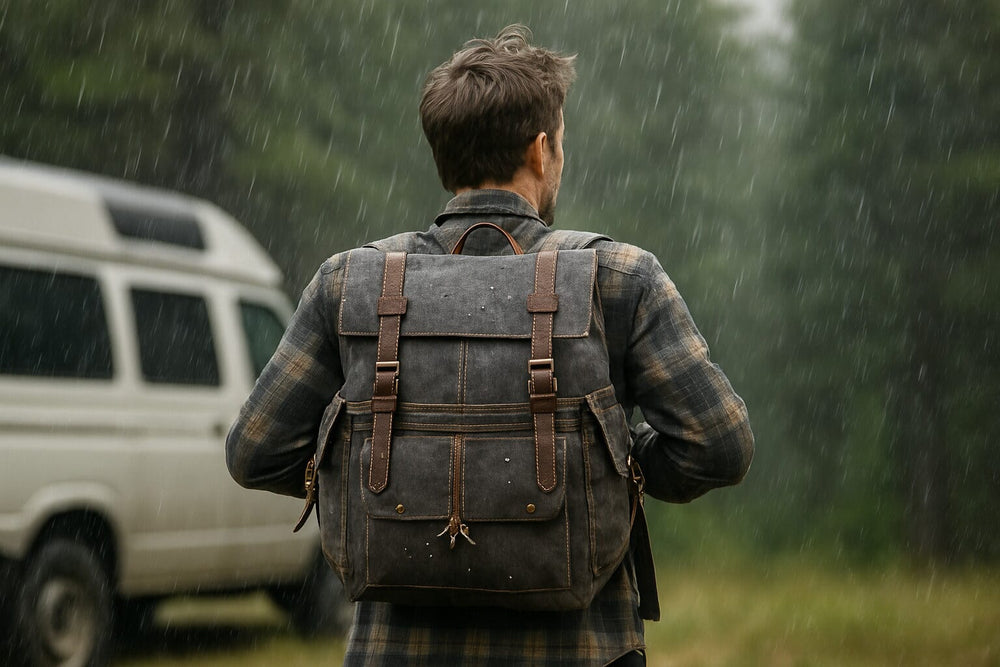
How to Know if a Bag is Waterproof (Without Getting Soaked)
Reading Time: about
Confused by labels like “waterproof,” “water-resistant,” and “water-repellent”?
You’re not alone.
This quick guide cuts through the jargon and shows you exactly how to tell if a bag can really handle rain, or just pretend to.
We’re here to help you see through the splashy claims and make smart choices, without soaking your gear or your wallet.
Waterproof, Water-Resistant, Water-Repellent: What’s the Difference? 🤔
-
Waterproof: Completely sealed – a waterproof bag lets no water through, even in heavy rain or brief submersion. Usually made with special materials (like PVC, TPU, or Gore-Tex), these bags often feature welded seams and watertight zippers or roll-top closures. Perfect for kayaking, hiking in storms, or keeping your gear bone-dry.
-
Water-Resistant: Okay for light rain – a water-resistant bag offers basic protection against moisture or short showers. Usually built with tightly woven nylon or polyester, often with a DWR (durable water-repellent) coating. But under heavy rain? Water will eventually seep through.
-
Water-Repellent: Makes water bead up and roll off – better than nothing, but still not fully waterproof. A repellent coating keeps light rain at bay, but don’t expect it to last forever or withstand extended downpours. These bags usually don’t have sealed seams or waterproof zippers.
Key takeaway: Water-resistant = light protection. Water-repellent = decent shield. Waterproof = all-in, rain armor.
How to Spot a Truly Waterproof Backpack 🔎💧
Here are the clear indicators to look for on a label or product description:
-
Waterproof Materials
Look for fabrics like TPU, PVC, vinyl, tarpaulin, or coated nylon (e.g. PU-coated). These materials block water completely and are often used for dry bags or marine gear. Bonus: water beads right off and won’t soak in. -
Welded or Sealed Seams
Waterproof fabric isn’t enough if the seams leak. Look for bags with welded or heat-sealed seams instead of traditional stitching. No needle holes = no leaks. Brands may highlight features like "welded seams, zero stitching" – a major green flag. -
Roll-Top Closure or Waterproof Zippers
-
Roll-top: Common in dry bags and moto packs. You roll the top, clip it, and create a tight seal that keeps water out.
-
Waterproof zippers: Look for YKK AquaSeal®, TIZIP®, or similar. These zips are reinforced and often coated for extra water-tightness. You’ll recognize them by their chunky build and stiff feel.
-
-
IP Rating (Ingress Protection)
IP ratings tell you how much water (and dust) a bag can handle:-
IPX4 = splash resistant
-
IPX6 = strong water jets
-
IPX7 = submersion up to 1m for 30 min
For serious waterproofing, look for IPX6 or higher. If a bag doesn’t list an IP rating, don’t assume it’s waterproof.
-
-
Clear Product Descriptions
Trust wording like: "submersible," "100% waterproof," "keeps contents dry under heavy rain". Be skeptical of vague phrases like: "weather-ready," "moisture defense," "treated for rain". If they don’t mention seams or zippers, water could get in.
Decoding Labels & Specs 🏷️🔎
-
Look between the lines: If the description says "water-repellent fabric" or "resists rain" but skips the seams or closure – it’s likely not fully waterproof.
-
Certifications & clues: Some brands include IP ratings or test results (e.g. "IP67 – submersible for 30 min"). Others highlight the materials (TPU, vinyl, etc.) or closure type (roll-top, waterproof zipper). These are your best indicators.
-
Beware of buzzwords: Terms like "weather-resistant" are marketing fluff unless backed by specs.
-
Match protection to use: Just commuting in light rain? A water-resistant or repellent bag may be enough. Planning a hike in heavy weather or kayaking trip? Go fully waterproof.
Quick Recap: How to Tell if It’s Waterproof
✅ Made of TPU, PVC, or coated nylon
✅ Welded seams (not stitched)
✅ Roll-top or waterproof zipper (YKK AquaSeal, TIZIP)
✅ IPX6 or IPX7 rating
✅ Described clearly as “fully waterproof” or “submersible”
⚠️ Red flags: vague marketing, no mention of seams or closures, DWR-only treatment
Final Word: Stay Dry, Stay Smart 🌦️🎒
Choosing the right bag doesn’t have to be a mystery. Just:
-
Know the terms (waterproof ≠ water-resistant)
-
Check the materials & construction
-
Match the protection level to your needs
When in doubt, go for clarity, not claims. Because no one likes a wet laptop.
FAQ 💬
Can I machine wash a waterproof bag?
Generally, no. Machine washing can damage waterproof coatings, zippers, and seams. Instead, wipe it down with a damp cloth and mild soap.
How long do waterproof coatings last?
DWR (durable water repellent) coatings can wear off with time, friction, and dirt. You can reapply it using spray treatments like Nikwax or Grangers.
Is a waterproof bag also dustproof?
If it has an IP rating, yes — the first digit (e.g. IP67) indicates dust protection. A 6 means completely dust-tight.
Can I fully submerge any bag labeled waterproof?
Not necessarily. Only bags rated IPX7 or higher are safe for full submersion. Check the label — “waterproof” isn’t always literal.
Is it worth getting a rain cover for a waterproof bag?
It can be! A cover protects against dirt, UV, and wear — and adds a layer of water protection, especially if your bag’s zippers aren’t fully waterproof.





Leave a comment